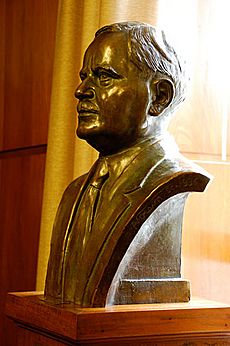Charles Martin (Oregon politician) facts for kids
- For the North Carolina congressman of the same name, see Charles H. Martin (congressman).
Quick facts for kids
Charles H. Martin
|
|
|---|---|
 |
|
| 21st Governor of Oregon | |
| In office January 14, 1935 – January 9, 1939 |
|
| Preceded by | Julius L. Meier |
| Succeeded by | Charles A. Sprague |
| Member of the U.S. House of Representatives from Oregon's 3rd district |
|
| In office March 4, 1931 – January 3, 1935 |
|
| Preceded by | Franklin F. Korell |
| Succeeded by | William A. Ekwall |
| Personal details | |
| Born |
Charles Henry Martin
October 1, 1863 Edwards County, Illinois |
| Died | September 22, 1946 (aged 82) Portland, Oregon |
| Political party | Democratic |
| Spouse | Louise Hughes |
| Profession | Military, politician |
Charles Henry Martin (born October 1, 1863 – died September 22, 1946) was an important American leader. He had a long career in the U.S. Army and later became a politician in Oregon. Martin served in the military for 40 years. He fought in several wars, including the Spanish–American War and World War I. He retired from the Army as a major general.
After his military career, Martin became a Democrat politician. He represented Oregon's 3rd congressional district in the U.S. Congress from 1931 to 1935. Later, he served as the 21st Governor of Oregon from 1935 to 1939.
Contents
Life and Career of Charles Martin
Early Life and Military Service
Charles Martin was born in Albion, Illinois, on October 1, 1863. He studied at Ewing College for two years. Then, he was accepted into the U.S. Military Academy at West Point. He graduated from West Point in 1887.
After graduating, Martin served actively in several conflicts. These included the Spanish–American War, the Philippine–American War, and the Boxer Rebellion. During World War I, he was a division commander. He led the famous Blackhawk Division and the U.S. V Corps. He also served as the U.S. Army Assistant Chief of Staff from 1922 to 1924.
Martin received the Distinguished Service Medal. He also earned two awards for bravery in battle. He retired from the Army as a major general on October 1, 1927. Before retiring, he commanded the Panama Canal Department for three years.
From Congress to Governor

After retiring from the Army, Charles Martin began a new career in politics. He moved to Portland, Oregon with his wife. From 1931 to 1935, he served in the U.S. Congress. He was a Representative for Oregon's Third Congressional District. He was known as a conservative Democrat.
In 1934, Martin was elected governor of Oregon. This was during the Great Depression, a very difficult economic time. He became known for helping to fix the state's money problems. As governor, he focused on several big issues:
- Helping Oregon recover from the Great Depression.
- Rebuilding the Oregon State Capitol building.
- Planning and building the Bonneville Dam.
- Improving ports and highways across the state.
When the Depression started to get better, Martin did not want to fully raise the pay for state employees. Their pay had been cut by half during the tough times.
Governor Martin's Challenges
Martin was seen as a governor who supported businesses. In 1935, timber workers went on strike. Martin said he would not let "pestiferous peewees" (meaning troublesome people) cause problems for his government. He believed that some union organizers were causing trouble. He even threatened to fire a sheriff for not being tough enough with striking workers.
In May 1935, Martin sent the state police and National Guard. They were there to protect workers who crossed picket lines during a mill strike in Gaston. In 1937, the National Guard was called again. This time, they were sent to deal with striking longshoremen.
Governor Martin also disagreed with President Roosevelt's New Deal programs. He especially disliked the National Labor Relations Board (NLRB). In 1937, a dispute between two large labor groups, the Congress of Industrial Organizations (CIO) and the American Federation of Labor (AFL), closed all sawmills in Portland. Martin stepped in and held his own elections to help reopen the mills. He also appointed Ralph E. Moody to prosecute union members accused of crimes.
Martin was famous for saying, "We have nothing to fear from the future except our own foolishness and slothfulness." However, his strong criticism of President Roosevelt hurt his political career. He lost his bid for the Democratic nomination for governor in 1938.
Later Life and Legacy
After losing the election, Charles Martin retired from politics. He lived in his home in Portland. He passed away on September 22, 1946. He was buried at River View Cemetery in Portland.


